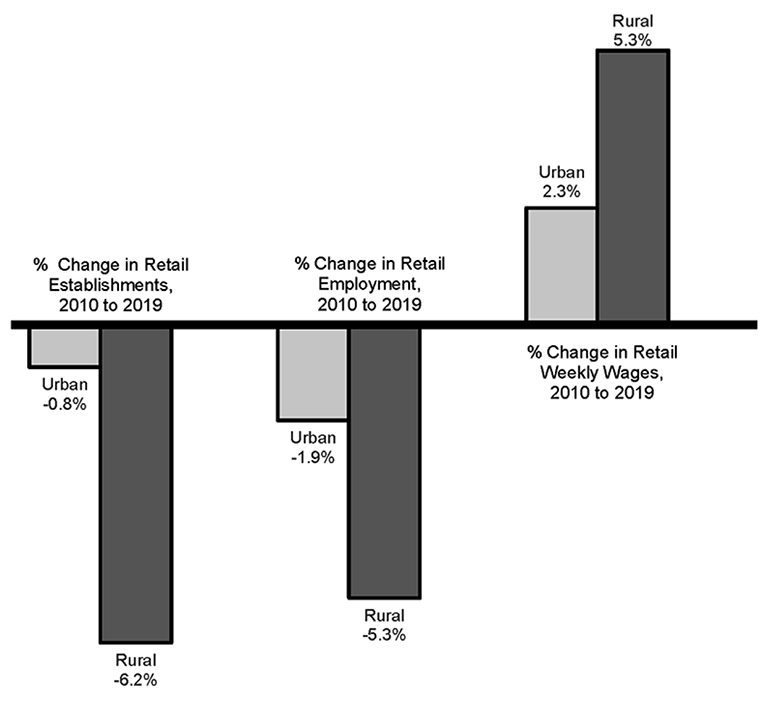Newsletters
- Home
- Publications
- Newsletter Archive
- Newsletter
January/February 2020
Inside This Issue:
- Center Board Announces 2020 Research Grants
- Chairman's Message
- Rural Snapshot: Fire Incidents in Pennsylvania
- Latest Center Research
- Just the Facts: Retail Businesses
Center Board Announces 2020 Research Grants
Congratulations to the recipients of the Center for Rural Pennsylvania’s 2020 Research Grant Program. In December, the Center’s board of directors awarded 13 grants, four to faculty at Pennsylvania State University and nine to faculty from the Pennsylvania State System of Higher Education (PASSHE) universities. Most of the research projects are set to begin on Feb. 1.
“The quality and scope of this year’s research projects are some of the best that we’ve seen over the past several years,” said Center Board Chairman Senator Gene Yaw. “The results of these studies will provide policy and decision makers with information that is unique to rural Pennsylvania and its nearly 3.4 million rural residents, and to urban Pennsylvania as well.”
The Center’s traditional Research Grant Program offers a maximum funding level of $50,000 per project per year. The Mini Grant Program offers a maximum funding level of $15,000 per project for a nine-month period.
2020 traditional grant projects
Coroner/Medical Examiner Services in Pennsylvania
Dr. Harry Holt of West Chester University of Pennsylvania will examine existing data and collect additional data via an online survey and in-person interviews from coroner/medical examiner offices statewide. The researcher will look to examine caseloads, funding, facilities, forensic capacity, vehicles and equipment, staffing and training resources, and other relevant factors. Based on the findings, the researcher will develop policy recommendations.
An Examination of Recycling Programs in Rural Pennsylvania, 2010-2018
Dr. Jennifer Haney of Bloomsburg University of Pennsylvania will examine the geographic extent and availability of recycling services and programs in rural counties, and compare them with those in urban counties. The researcher will also test a number of theories concerning economic and environmental issues impacting recycling programs in rural and urban Pennsylvania.
The Recruitment and Retention of Substance Abuse Treatment Workers in Rural Counties
Dr. Jennifer Murphy of Pennsylvania State University €“ Berks will use existing data and gather new data to examine the barriers for the recruitment and retention of skilled substance abuse treatment workers in rural Pennsylvania.
Small Town Police Chiefs: Profile and Concerns
Dr. Jennifer Gibbs of Pennsylvania State University €“ Harrisburg will survey and interview police chiefs serving municipalities with fewer than 10,000 residents to create a profile of departments, explore trends from a previous survey conducted in 2005, and identify perceptions of current topics.
Planning in Rural Pennsylvania in 2020: Analysis of the Effectiveness of Municipal Land Use Tools
Dr. Dorothy Ives Dewey of West Chester University of Pennsylvania will provide an update of the report, Measuring the Effectiveness of Comprehensive Planning and Land Use Regulations in Pennsylvania, which was sponsored by the Center in 2001. The research will determine the extent to which land use planning tools are being used across the commonwealth today, and to assess their impact and effectiveness in managing growth and development.
Access to Mental Health Services in Rural Pennsylvania
Dr. Ahyoung Lee of Kutztown University of Pennsylvania will use a mixed-methods approach to explore factors affecting access to mental health services along a continuum of care and across five domains that influence health equity and health disparity. Based on the findings, the researcher will develop policy recommendations.
2020 Rural Youth Survey: Trends and Developments in the Attitudes and Aspirations of Rural
Pennsylvania Youth
Dr. Lacey Wallace of Pennsylvania State University €“ Altoona will expand on the previous Rural Youth Education Project, which was sponsored by the Center in 2004 to 2011, by collecting data from 9th and 11th grade students in 15 randomly selected rural school districts. The research will broaden the scope of the prior data collection by surveying school administrators and collecting more detailed data on peers and delinquency.
Access to Maternity and Obstetric Services in Rural Pennsylvania
Dr. Sharon DeJoy of West Chester University of Pennsylvania will analyze the supply, demand, and distribution of the obstetric workforce and obstetric services in rural Pennsylvania. The researcher will also identify barriers and solutions to increasing access, with an emphasis on policy solutions.
2020 mini-grant projects
Analysis of the 2017 Census of Agriculture Data
Dr. Sunita Mondal of Slippery Rock University of Pennsylvania will use Census of Agriculture data to conduct an in-depth analysis of farmers and farm operations in Pennsylvania, and identify existing trends. This research will develop profiles of farmers and farm operations based on demographics, farm characteristics and farming practices, and will identify changes over time.
Profile of Rural Pennsylvania Women
Dr. Diane Shinberg of Indiana University of Pennsylvania will use existing data to describe the life circumstances of rural Pennsylvania women. The researcher will identify trends over a 10-year period, and will compare the findings with urban Pennsylvania women and rural and urban Pennsylvania men.
An Overview of Pennsylvania’s Public School Transportation
Dr. Liang Xu of Slippery Rock University of Pennsylvania will provide an overview of public school transportation in Pennsylvania. The research will contrast the differences between rural and urban school transportation services, provide more information about the school transportation service structure, and identify trends and challenges associated with public school transportation in rural and urban Pennsylvania.
Analysis of Burial Laws in Pennsylvania
Dr. Andrea Palmiotto of Indiana University of Pennsylvania will analyze Pennsylvania burial laws and conduct case studies in areas where forgotten cemeteries or human remains were discovered during construction and development. The research will compare the diversity of legislative interpretations within Pennsylvania, and provide examples of legislation from other states.
Suicide Trends and Prevention in Rural Pennsylvania
Dr. Daniel Mallinson of Pennsylvania State University €“ Harrisburg will gather data on suicide trends in rural and urban Pennsylvania counties and assess those trends from 1990-2016. The research will then develop an inventory of suicide prevention programs in Pennsylvania’s 67 counties and 500 school districts. This inventory will be conducted via web surveys to all county mental health officers and school districts. The survey will ask for details of programs deployed in the schools, resources for those programs, and efforts at assessing the effectiveness/impact of the programs.
For more information about the Center’s Research Grant Program, click here.
Chairman's Message
Happy New Year. If you’ve set any goals or resolutions for yourself this year, I hope that participating in Census 2020 is one of them. By April 1, 2020, every home in the U.S. will receive an invitation to participate in the 2020 Census. When you get your invitation, you are responding for your household, and you can submit your information online, by phone, or by mail. When you fill out the census information, you tell the Census Bureau where you live as of April 1, 2020.
Like prior censuses, the 2020 Census will provide a snapshot of our nation’s population. The results are vitally important to our state because this once-a-decade information helps businesses, researchers, and communities make decisions. Here at the Center, we use Census data almost every day to answer questions from state and local government officials, businesses, educators, residents, and nonprofit organizations. In many issues of this newsletter, Census data are behind the analyses and comparisons we provide in the articles.
Most of our partner researchers have also used Census data in their research projects, and many will use that data this year, as highlighted on Pages 1 and 3.
The research projects approved for 2020 by the Center’s Board of Directors cover a wide range of issues. These include coroner services, the recruitment and retention of substance abuse treatment workers, the use of municipal planning tools, access to mental health services, access to maternity and obstetric services, attitudes and aspirations of rural youth, small town police services, recycling programs, rural women, agriculture, burial laws, public school transportation, and suicide trends and prevention. We look forward to working with our partner researchers and will share the results of their projects with you upon completion.
In December, the Center released a report on the potential economic implications of the Spotted Lanternfly, the invasive insect that is now present in 14 Pennsylvania counties. According to the research, the overall annual direct economic impact of Spotted Lanternfly damage on Pennsylvania agriculture would be $13.1 million in those 14 counties alone. The overall annual impact of the insect feeding on forest trees is estimated to be $16.7 million in those same 14 counties. If this insect travels beyond those counties, which are now part of a quarantine zone, the economic impact to agriculture and forests could be far worse. Turn to the article on Page 6 for a short synopsis of the research and visit the Center’s website for the full report. If you want more information about the insect and how to stop it from spreading, visit Penn State Extension’s website at https://extension.psu.edu/spotted-lanternfly.
Senator Gene Yaw
Rural Snapshot: Fire Incidents in Pennsylvania
About the data: The data used in this Snapshot are from the 2015, 2016, and 2017 National Fire Incident Reporting System (NFIRS) public release data files, Basic Module. NFIRS is a voluntary reporting system used by fire companies across the U.S. The database is maintained by the Federal Emergency Management Agency’s U.S. Fire Administration. Information about each incident is entered by individual fire companies. Because participation in NFIRS is voluntary, the database does not include a complete count of all reported fire and hazardous incidents nor is it a survey based on a statistically selected sample. Therefore, the analysis presented here should not be considered a complete inventory or a representative sample of fire and hazardous incidents in Pennsylvania. The analysis included only volunteer fire companies and companies that are a combination of paid and volunteer companies. The analysis excluded companies that provided mutual aid to avoid duplication of data. Click here for a copy of the fact sheet, Fire Incidents in Pennsylvania, 2015 to 2017.
Pennsylvania Volunteer and Combination Paid/Volunteer Fire Companies Included in the National Fire Incident Reporting System (NFIRS)
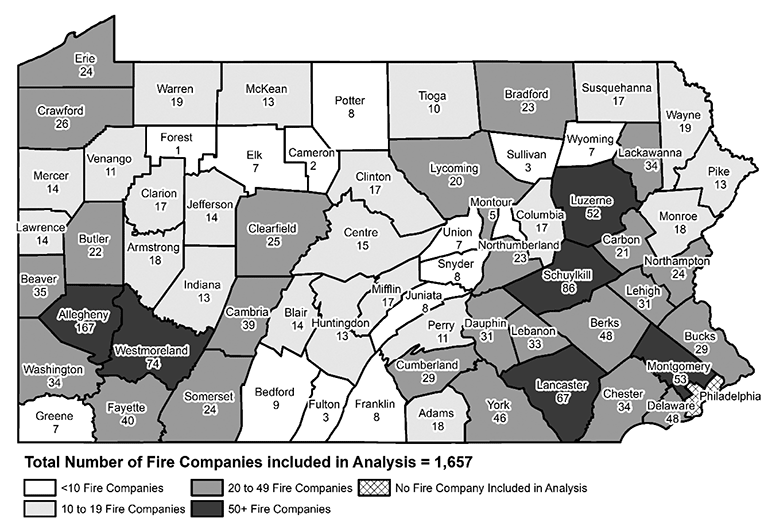
Types of Reported Rural and Urban Fire and Hazardous Incidents, 2015 to 2017
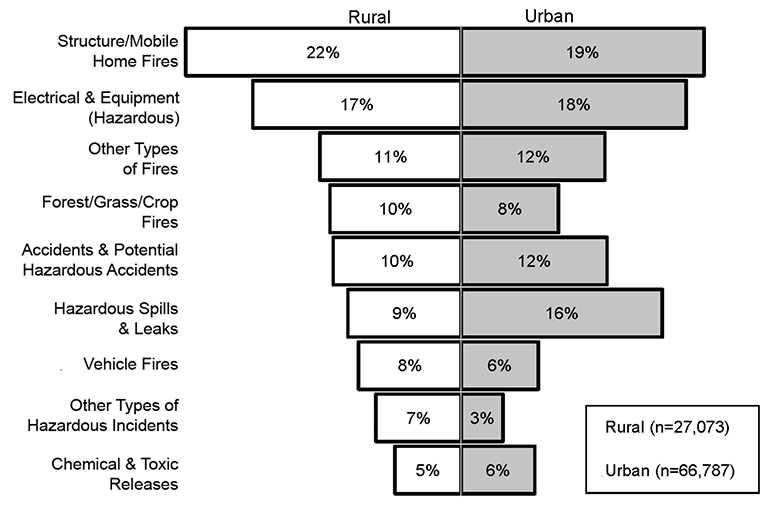
Time of Alarm Received for Rural and Urban Fire Companies, 2015 to 2017
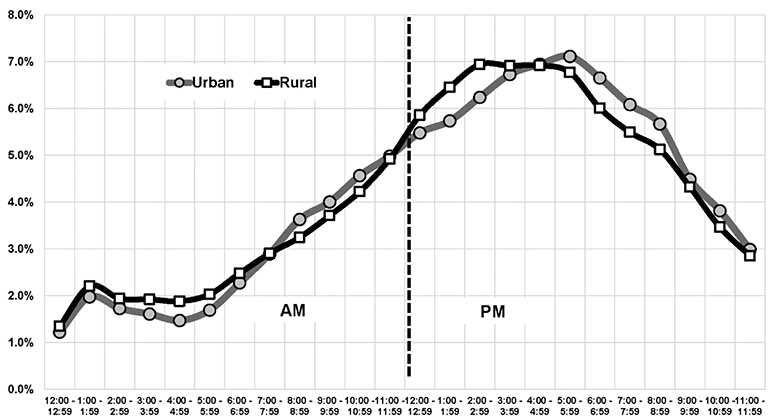
Average Response Time for Rural and Urban Fire Companies, 2015 to 2017
(Time from when call was received to when first unit arrived on scene)

Average Number of Personnel and Apparatus that Respond to Fire and Hazardous Incidents, 2015 to 2017
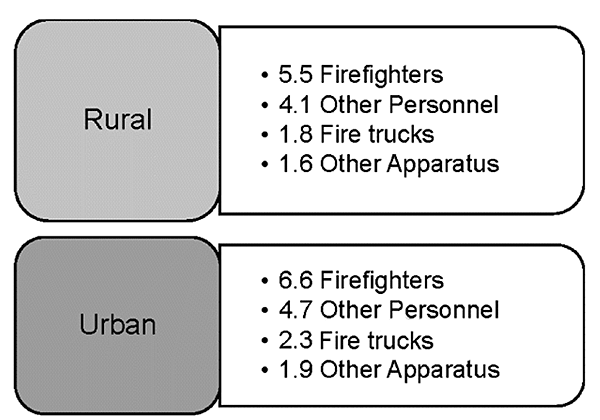
Estimated Property Loss from Fires in Rural and Urban Pennsylvania, 2015 to 2017
Data only included property losses of $1 or more.
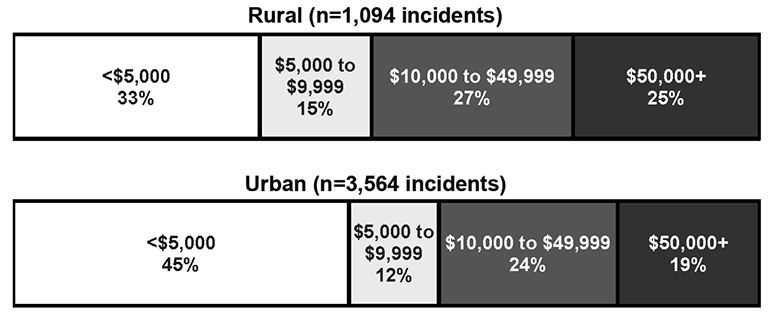
Latest Center Research
Potential Economic Impacts of the Spotted Lanternfly
The invasive insect, Spotted Lanternfly (SLF), is currently destroying vulnerable agriculture crops and tree species in Pennsylvania. This study estimated the total economic impact of the SLF in Pennsylvania by considering several scenarios. These include estimates based on damages (1) if SLF is successfully limited to the 14 counties in the quarantine zone only (Berks, Bucks, Carbon, Chester, Dauphin, Delaware, Lancaster, Lebanon, Lehigh, Monroe, Montgomery, Northampton, Philadelphia, and Schuylkill counties), (2) if SLF expands to 12 counties adjacent to the quarantine zone (Adams, Columbia, Cumberland, Franklin, Lackawanna, Luzerne, Montour, Northumberland, Perry, Pike, Wayne, and York counties), and (3) if the SLF expands statewide, directly affecting all 67 counties in Pennsylvania. Dr. Jayson Harper, Dr. William Stone, Dr. Timothy Kelsey, and Lynn F. Kime of Penn State University conducted the study in 2018-2019.
To calculate the direct impacts of SLF on Pennsylvania agriculture, the researchers used data from the 2017 Census of Agriculture and a survey of crop production experts. From this data, it is estimated that the expected overall annual direct economic impact of SLF damage on Pennsylvania agriculture is $13.1 million in the quarantine zone, $7.7 million in the adjacent counties, and $42.6 million statewide. Losses to SLF are projected to fall particularly heavily on nursery operators, fruit growers, especially grape growers, and Christmas tree growers.
To calculate the direct impacts of SLF on the Pennsylvania forestry industry, the researchers used data from the U.S. Department of Agriculture’s (USDA) Forest Inventory and Analysis database, quarterly price data from the PA Timber Market Report, and a survey of forestry production experts. The overall annual impact of the SLF feeding on forest trees is estimated to be $16.7 million in the quarantine zone, $15.6 million in the adjacent counties, and $152.6 million statewide. SLF feeding on forests is projected to cause considerable economic damage over time, especially to soft maple, various oak species, and black walnut.
Child Sexual Abuse and Exploitation in Pennsylvania
This research reviewed more than 2,000 Pennsylvania Children and Youth Services (CYS) reports of child sexual abuse or sexual exploitation across 10 Pennsylvania counties in 2016 and 2017. The research was conducted initially to understand the characteristics of Commercial Sexual Exploitation of Children (CSEC), and how it is identified and investigated by CYS caseworkers.
The research identified challenges in multiple steps of the CYS process, from the initial screening of child abuse reports to the actions of the State Commonwealth Court. Ultimately, the research turned into a more thorough review of reporting and investigative practices in child sexual abuse and exploitation cases.
The researchers acknowledged the work of the Office of the Auditor General, as well as the state’s Child and Family Services Review that identified concerns with CYS resources and practices. However, those efforts focused largely on fatalities, near fatalities, and children in foster care, which represent a small proportion of children at risk of, or victims of, maltreatment. Child sexual abuse is almost never lethal and rarely results in foster care placement due to the presence of a non-offending parent. Therefore, sexual abuse cases are poorly represented in most oversight and evaluation efforts.
The researchers also commended the leadership of the Office of Children Youth and Families (OCYF) and the 10 Commonwealth counties for their participation in data-driven efforts to identify problems and arrive at solutions. Solving these issues requires a coordinated response by OCYF, county CYS leadership, the legislature, and the courts, as well as research and evaluation partners. The researchers provided six recommendations that, taken together, could position Pennsylvania as a national model for child protection.
Click here for a copy of the research reports, Potential Economic Impact of the Spotted Lanternfly on Agriculture and Forestry in Pennsylvania, and Child Sexual Abuse and Exploitation in Pennsylvania.
Just the Facts: Retail Businesses
Shopping isn’t what it used to be. According to data from the U.S. Bureau of Labor Statistics, the number of Pennsylvania rural and urban retail establishments are on the decline.
In the second quarter of 2019, there were 11,039 retail establishments in rural Pennsylvania, a decline of 6 percent from 2010. In urban areas, there was a 1 percent decline in retail establishments. In rural areas, there is one retail establishment for every 307 residents, and in urban areas there in one establishment for every 316 residents.
Pennsylvania wasn’t the only state to see a decline in retail, as 28 other states had either a decline or no change in the number of establishments from 2010 to 2019. The three states with the highest declines were Vermont, Kansas, and New Jersey, each with an 8 percent or more decline. The three states with the highest increases were Michigan, Texas, and Utah, each with an increase of 10 percent or higher.
In rural Pennsylvania, not all retailers were on the decline. General merchandise stores, gas stations, and non-store retailers, such as catalogs or online stores, increased in number. Among rural retailers that had the steepest decline were clothing and clothing accessory stores, furniture and home furnishing stores, and sporting goods, hobby, book and music stores.
The decline in retail establishments has been closely followed by the decline in retail employment. From 2010 to 2019, the number of rural retail workers has declined 5 percent. Urban areas had a 2 percent employment decline. Despite the decline, average weekly wages increased for both rural and urban retail workers (5 percent and 2 percent, respectively).
Nationwide, retail employment increased 8 percent from 2010 to 2019, and average weekly wages increased 8 percent.
Percent Change in Rural and Urban Pennsylvania Retail Businesses, Employment, and Weekly Wages, Second Quarters 2010 to 2019
